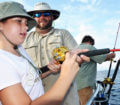Editor’s Note: Over 100 days a year, Captain Randy Boggs of the “Reel Surprise” charter boat (https://www.reelsurprisecharters.com/) out of SanRoc Cay Marina (http://www.sanroccay.com/marina) in Orange Beach, Alabama, is fishing for red snapper. During snapper season, his customers can keep the red snapper, and after snapper season, they can make pictures of the red snapper they catch and then release. Here are some of Randy Boggs’ red snapper catching secrets.
 “Secret 3: Test your knots,” Captain Boggs emphasizes. Put on a pair of gloves, hang the point of your hook over some type of metal on the boat, pull on the line, and look at the knot that you’ve used to attach the hook. By pulling on the line, you can see if the knot slides or pulls out of the eye of the hook. If the knot ever slips, then more likely the line will be to break at the knot. If our boat gets into a good school of snapper, and all the snapper in the school weigh 10 or 12 pounds apiece, when you hook one snapper, the other snapper will swim around the fish that’s hooked, trying to see what’s happening. If you break the fish off – either because of a weak line or more than likely a knot that hasn’t been tied securely – the fish that got off the hook will swim toward the bottom and usually dive into the wreck or the reef. So, when that fish goes down, all the fish in the school will follow it down. Then you’ll have a difficult time catching another snapper off that spot.
“Secret 3: Test your knots,” Captain Boggs emphasizes. Put on a pair of gloves, hang the point of your hook over some type of metal on the boat, pull on the line, and look at the knot that you’ve used to attach the hook. By pulling on the line, you can see if the knot slides or pulls out of the eye of the hook. If the knot ever slips, then more likely the line will be to break at the knot. If our boat gets into a good school of snapper, and all the snapper in the school weigh 10 or 12 pounds apiece, when you hook one snapper, the other snapper will swim around the fish that’s hooked, trying to see what’s happening. If you break the fish off – either because of a weak line or more than likely a knot that hasn’t been tied securely – the fish that got off the hook will swim toward the bottom and usually dive into the wreck or the reef. So, when that fish goes down, all the fish in the school will follow it down. Then you’ll have a difficult time catching another snapper off that spot.
“Secret #4. Set-up, and use the drag system on your reel.” The fisherman standing next to me when we pulled up on a spot that was holding big snapper got a tremendous bite from a really big snapper. The fish was pulling off drag from the reel as it swam away from the boat. Immediately, the angler who had hooked the fish reached to the front of his saltwater reel and tightened the drag. The fish continued to pull hard, and the drag kept slipping like it was supposed to do. Once again the angler reached to the front of his reel and tightened the drag, which slowed the charge of the fish. But the big snapper pulled line off the reel. The third time the angler reached to the front of the spinning reel and tightened the drag, the line snapped, and the big snapper was gone.
 I asked Captain Boggs, “How should you adjust the drag on your reel to keep from losing big snapper?” According to Captain Boggs, “The Gulf of Mexico, especially out of Orange Beach, Gulf Shores and Dolphin Island, is primarily a flat bottom. There was so much turbulence when Hurricane Ivan came through on September 16, 2004, that many of the artificial reefs were destroyed. So, most of the time when you hook a big snapper in these areas, the fish will go down and run away from the reef, however, very seldom, if ever, do we have a big snapper dive into the reef where the reef will cut or break the line. We fish 32 people per day and about 100 charters per year. We have very-few people on our boat who lose a good-sized red snapper because of hanging up in the bottom. We fish with circle hooks. When the snapper gets hooked, the hook turns in the fish’s mouth and usually hooks the fish in the corner of its mouth or lips.
I asked Captain Boggs, “How should you adjust the drag on your reel to keep from losing big snapper?” According to Captain Boggs, “The Gulf of Mexico, especially out of Orange Beach, Gulf Shores and Dolphin Island, is primarily a flat bottom. There was so much turbulence when Hurricane Ivan came through on September 16, 2004, that many of the artificial reefs were destroyed. So, most of the time when you hook a big snapper in these areas, the fish will go down and run away from the reef, however, very seldom, if ever, do we have a big snapper dive into the reef where the reef will cut or break the line. We fish 32 people per day and about 100 charters per year. We have very-few people on our boat who lose a good-sized red snapper because of hanging up in the bottom. We fish with circle hooks. When the snapper gets hooked, the hook turns in the fish’s mouth and usually hooks the fish in the corner of its mouth or lips.
“You can lead a snapper anywhere you want it to go when you hook it in the corner of its mouth or the lips, if you don’t put too much force on the line and the hook. If we’re using 50-pound-test line, we’ll set the drags on our reels at 12 pounds. We’ll test that drag by tying the line to a measuring scale to make sure that the line slips when there’s more than 12 pounds of force applied to the end of the line. Once you set the drag on the reel never, ever tighten that drag – especially when you have on a big fish. We suggest to our customers that they test their drags three or four times during the day to make sure their drags don’t stick, and that when they pull against the line, that the reel lets the line slip off the reel. The drag is supposed to slow the charge of the fish and tire it out, so you can reel it into the boat. If your drag isn’t set loose enough to let the line slip when a big fish runs, more than likely you will break that fish off.”
 “The 43-Pound Wahoo:” https://youtu.be/4D1Q1_6nJr4
“The 43-Pound Wahoo:” https://youtu.be/4D1Q1_6nJr4
Contact Captain Randy Boggs at https://www.reelsurprisecharters.com/ and 251-981-7172.
To learn more about saltwater fishing, check out “Alabama’s Inshore Saltwater Fishing: A Year-Round Guide for Catching More Than 15 Species,” “Alabama’s Offshore Saltwater Fishing: A Year-Round Guide for Catching Over 15 Species of Fish,” “Fishing Mississippi’s Gulf Coast and Visitor’s Guide,” “How to Fish Mississippi’s Gulf Coast in June” and “13 Saltwater Fish Recipes You Can’t Live Without,” available in Kindle eBooks and some print books.










